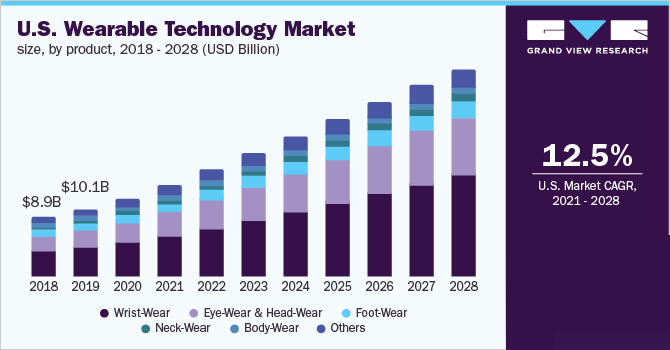
Evolving Wearable Technology Spectrum
The wearable technology market has been soaring continually in recent years. The increasing adoption of wearable devices, primarily tracking and monitoring body vitals, is a key driving force. Given the growing sale of smartwatches and other wearable devices for consumer applications, the market value is expected to grow to USD 50 billion by 2022, expanding at an 18.72% CAGR throughout the assessment period (2016-2022).
The insertion of wearable technology in people’s lives goes far beyond fitness trackers, wireless headphones, and smartwatches. With rapid technology upgrades, wearables have taken a quantum leap in a very short time. From GPS-enabled tracking devices to DoD, wearables hold great potential to have positive implications for military capability and general health research.
Currently, around 320 million consumer medical wearables are available in the market, ranging from heart rate monitors to bracelets aiding in ovulation prediction and conception. Given the popularity of fitness devices that consumers are incorporating into their daily lives, the future of wearable technology appears promising. These low-power, high-performance, next-generation wearable devices are witnessing a significant market demand.

Global Wearable Technology Market
Industry players strive to deliver the cutting-edge performance of wearable devices, offering a wide range of products and solutions that are reliable, powerful and easy to incorporate. Talking about the development in the world of wearable technology, the world has witnessed plenty of disruptive innovations. Some of them are beyond our imagination, such as smart textiles or AI in clothing.
Wearable Devices and Data Uses
A common factor among these wearables is that they all monitor data in real-time. However, receiving, using, and sharing wearable technology data is at the core of this fundamental shift. While wearable devices have been improving healthcare in rural areas and low-resource environments, it is also reestablishing the importance of robust data architecture.
It is critical to capture, store, access, and transform this data in cloud data centers as well as at the edge, within servers, and endpoints. Due to the proliferation of wearable technology, data is collected at an unprecedented rate today. This further brings a need for high-capacity drives to store massive amounts of data in the cloud. On the other hand, data generated by wearables at the endpoints demands reduced network latencies and increased throughput between cloud-to-edge and edge-to-endpoints layers.
Key Trends Driving Wearable Technology Market
Wearable devices are becoming smarter, lighter, and more convenient while continuing to add features and capabilities. The rising popularity of wearable devices leads to the growing adoption of wearable devices. The growing sales of wearable devices, particularly fitness tracking & health monitoring devices, boost the market demand exponentially. The adoption rate and market sales are primarily influenced by advances in sensor technology and wearable technology gadgets.
Also, factors such as the increasing penetration of smartphones, mobile networks & applications, computing, and broadband connectivity define the growing market landscape. Moreover, the digitalization and proliferation of the Internet of Things (IoT) accelerate the Wearable Technology Market shares.
While rising applications of wearable technology in clothing and health monitoring devices would support the market growth, large R&D expenditures and long development & commercialization times required for the development of technology are significant headwinds for the growth of the market. Also, limited battery life is a major issue the wearable industry faces currently, and users constantly demand an extended battery life.
Industry Players’ Strategies to Follow
Wearable device providers are constantly working on extending battery life by having an ultra-low-power operation. They are also continually focusing on providing a better user experience by improving the performance, integration & miniaturization of their products and safety & security. At the same time, they ensure that their devices have differentiating value and are aesthetically appealing.
To reduce the cost of development and market risks, providers of wearable technology collaborate with other players. In addition to benefitting from each other’s marketing platform, such mergers & acquisitions, distribution partnerships, and collaborations also benefit them by reducing commercialization times and achieving a larger footprint & proprietary technology.
Notable Industry Updates
On June 16, 2022, Clario, a technology company, announced a partnership with ActiGraph, a leading provider of activity-sensing wearable technology, to expand its broad evidence generation platform and portfolio of decentralization technologies further.
This collaboration will further aid in improving patient experience and study efficiency through wearable technology while capturing a wider range of activity & sleep data. The partnership would enable Clario to offer ActiGraph technologies to its customers, alongside its suite of eCOA, precision motion, respiratory, cardiac safety, medical imaging and trial enablement solutions.
Along with the longevity, regulatory agencies and patients also expect improved quality of life. Especially, regulatory bodies see the quality of life as a critical patient-reported outcome (PRO) and seek evidence of how clinical interventions change the way patients feel overall. Consequently, endpoints-related activities are required in clinical studies across many therapeutic areas.
